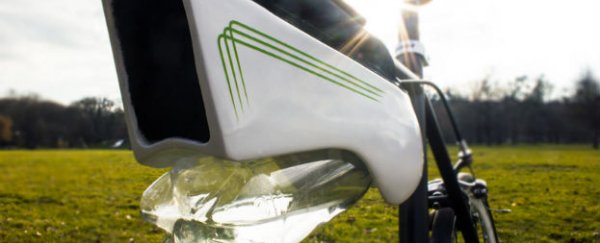A new self-filling water bottle has been invented that can not only serve as a nifty device for long bike tours and races, but could also offer a new method of fresh water collection in parts of the world where groundwater sources are hard to come by.
Developed by industrial designer Kristof Retezar from Austria's University of Applied Arts, the new device - called the 'Fontus' - works best in humid weather, which allows it to condense the moisture in the air into safe, fresh drinking water. Experiments have shown that under the right weather conditions, it can produce 0.5 Litres of water in just under an hour.
"My goal was to create a small, compact and self-sufficient device able to absorb humid air, separate water molecules from air molecules and store water in liquid form in a bottle," says Retezar at the James Dyson Award website.
Retezar says he was inspired to invent the device as something that could be beneficial to some of the 2 billion people in more than 40 countries that live in regions where clean and safe sources of water are scarce. According to the UN, by the year 2030, 47 percent of our global population will be living in areas of high water stress. So he decided to take a 2,000-year-old technology - ancient civilisations from Asia and Central America were some of the first to employ it - that taps into some of the 13,000 kilometres cubed of fresh water held in the Earth's atmosphere.
Retezar explains how it works at the James Dyson Award website:
In order to achieve condensation, one must cool hot, humid air down. The device has a small cooler installed in its centre called Peltier Element. This cooler is divided in two: When powered by electricity, the upper side cools down and the bottom side gets hot. The more you cool the hot side down, the colder the upper side will get. Consequently, these two sides are separated and isolated from each other.
The air enters the bottom chamber at a high speed when moving forward with the bike and cools the hot side down. Moreover, when the air enters the upper chamber it is stopped by little walls perforated non-linearly, reducing its speed in order to give the air the needed time to lose its water molecules.
Once the water molecules have been extracted, the droplets flow through a pipe and accumulate in a bottle. This bottle can be easily loosened from its holder for drinking, and any kind of PET 0.5 L bottle will fit.
The Fontus has been entered into the James Dyson Award, which is an annual, international design competition, and a win could provide Retezar with the capital to jettison his design to the market.

Sources: James Dyson Award, DesignBoom
